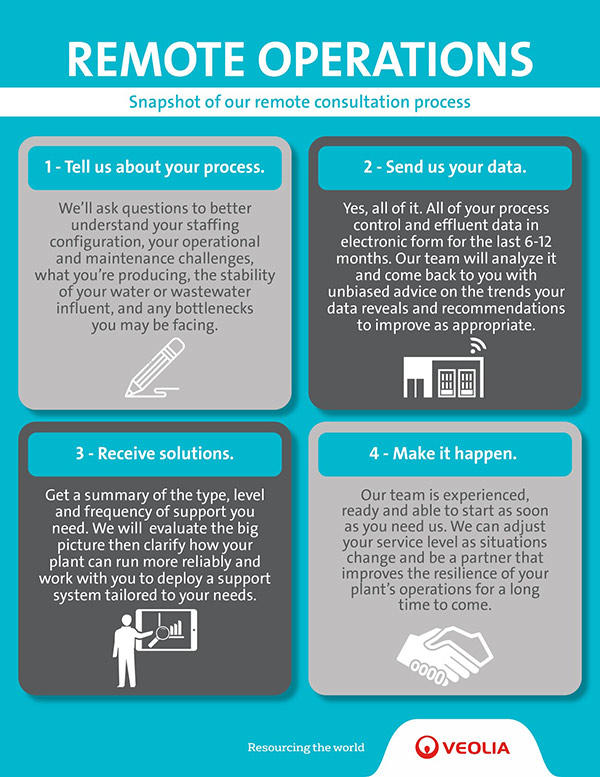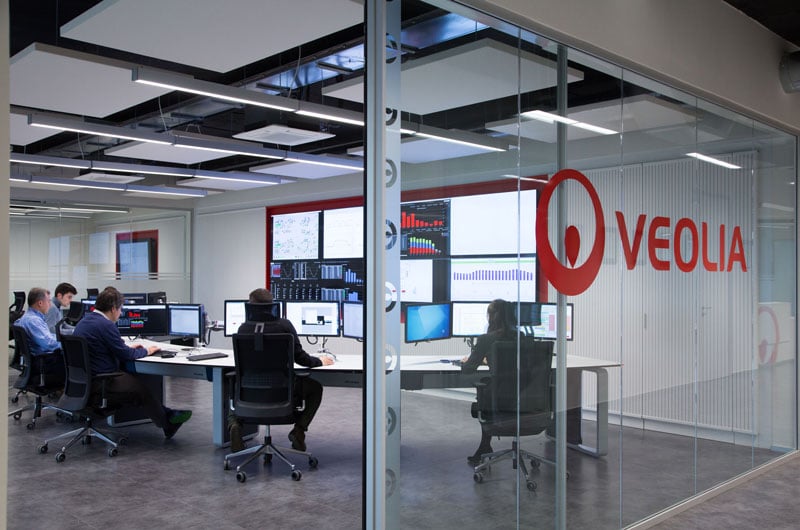For many organizations, the task of maintaining business continuity with fewer people onsite or in the workplace has been little more than an inconvenience. However, for industrial facilities required to stay up and running, the challenge has been much more critical. The dilemma plants often face — especially now during the COVID-19 pandemic — is how they can ensure safe, efficient and profitable production when emergencies arise.
Operators must ask: what are some important aspects to consider when it comes to ensuring smooth operations even in complicated times like these?
Automated or not, your plant needs supervision
For the most part, industrial plants do not have the luxury of allowing a large portion of their employees and contractors to work remotely.
Even in highly automated facilities or those with minimal hands-on staff, mission-critical equipment and systems need to be inspected and maintained.
With industrial water or wastewater treatment plants, continuous or periodic monitoring of process parameters is often required to ensure that customer and regulatory requirements are being met, and that systems are operating smoothly.
In recent months, monitoring has become more complex as operators have had to add recommended health procedures and social distancing guidelines to their everyday safety and operations protocols. The pandemic is doubly complicated by weather events like hurricanes, flooding, tornadoes and other emergencies.
For many industrial facilities that rely heavily on onsite monitoring and hands-on intervention, ensuring uptime and performance becomes increasingly difficult.
Balancing hands-on oversight with remote monitoring
One strategy to enhance continuity of operations is setting up remote operations support. This comes in many forms and can range from a simple third-party consultation, to the implementation of a full-scale remote monitoring solution for the entire plant.

In industrial water and wastewater treatment facilities, consultations typically start with a meeting to assess the issue or need – whether it’s performance inconsistency, a process upset or problem with meeting effluent requirements.
Specialists talk to your staff, review onsite process control and water quality data (both current and historical), and look at relevant information about treatment chemistry, maintenance procedures, laboratory testing practices, etc.
Based on the evaluation, they then prepare a package of recommendations that is customized according to the resources of the plant, such as staffing, equipment and capital.
You get the benefit of someone new looking at your facilities with a new point of view and can choose the recommendations you wish to implement.
In doing so, process continuity can be maintained with minimal physical onsite interaction.
Smart monitoring for continuous socially distanced oversight
“Smart monitoring” is another option which enables operators to continually optimize water and wastewater plant performance and efficiency from another location.
Thanks in large part to the proliferation of digital technologies, along with advances in the field of smart sensors and meters, real-time monitoring of virtually any physical system or process is now possible.

Critical process variables, such as temperatures, pressure, flow rate, electricity consumption, etc., can be transmitted through secure, cloud-based platforms. If any of those variables deviate from pre-set, automated protocols, plant operators and even designated outside consultants are alerted, regardless of where they are located, even offsite.
By automating certain monitoring aspects and transferring a portion of responsibility to a offsite provider, operators can reduce risk while ensuring compliance with recommended health and distancing guidelines. There is also the added benefit of alleviating the workload on onsite personnel and allowing them to focus on other critical areas of need related to engineering, operations and maintenance.
Using third parties can also offer you a fresh perspective on your plant and outside experience that can augment your team’s capabilities and mutually determine best practices. With easily accessed dashboards and meaningful data, operators can quickly determine what action needs to be taken to avoid a process upset. The data monitored can vary widely depending on the type of system, the calculation capacity, the level of detail sought, and even the applicable visualization or reporting solutions.
Revisiting your emergency plans when things change
Emergency preparedness can mean the difference between continued operations through extreme challenges and disaster.
A key factor to business continuity, of course, is pre-planning, and every facility has plans to follow in an emergency. However, industrial operators may have to reevaluate contingency plans to accommodate for changes that may happen along the way.
Natural disasters and other emergencies obviously disrupt business as usual, but this year, the need to protect employees from COVID-19 exposure in addition to unforeseen situations requires a layered approach.
A global pandemic is not something that any of us — including industrial operators — thought they would ever have to plan for. Most plants have simply had to adapt “on the fly” to minimize disruption to their day-to-day operations and ensure the safety and well-being of their employees.
In the midst of the shuffle, it is likely that any planning related to other potential crises or emergencies has been put on the backburner. However, the time to evaluate these plans is not when the crisis is imminent. This is especially relevant now, with hurricane season in North America underway.
Is your wastewater treatment plant ready for a COVID-19/hurricane season?
An effective hurricane preparedness plan for 2020 is going to look markedly different from years past. It will certainly require the same measured forethought and thorough deployment as always, but with new risk factors entering the equation, unique measures will have to be implemented.
Operators must ask themselves how existing plans will be impacted given the current state of affairs.
- How can we quickly evacuate people, while adhering to social distancing guidelines?
- How can we ready the plant in a timely manner with fewer people onsite?
- Do we need to conduct additional training
Have our contractors or vendors made changes to their policies that we need to be made aware of?
These are just a few of the questions that should be addressed when developing a hurricane preparedness plan for 2020 and beyond.
Operators must also acknowledge the reality that the landscape could change in the coming months. Plans and policies need to be flexible and adaptable to account for the range of possible circumstances.
Having a well-defined, well-communicated plan mitigates risk
Revising crisis policy is only the first step when it comes to mitigating risk and building resiliency. Operators must also ensure that any new procedures or plans are communicated to all relevant stakeholders, including employees, customers, contractors, etc.
In the world of a pandemic, there are multitudes of corporate communications, all of which are competing for the attention of personnel. As industrial organizations roll out their emergency plan, whether it be for a hurricane or even a less impactful event, such as a chemical spill or environmental release, it is important that any pertinent information is not only seen, but understood by those who will be involved in the response.
By ensuring that all employees understand protocol changes you can avoid
- Unplanned shutdowns
- Unnecessary lapses of social distancing resulting in COVID-19 exposure
- Consequential outbreak of COVID-19 due to panicked behavior
- Confusion, injuries and fatalities in the face of an emergency
- Reduced efficiency
- EPA violations
The impact of a well-defined emergency response plan should not be underestimated. This is true even under normal circumstances, but it is especially the case in the midst of a global pandemic, which has created an entirely “new normal."
In these unprecedented and highly uncertain times, industrial enterprises must be prepared to operate in a business environment where volatility is not only probable, but inevitable. Resiliency is now contingent on the ability of organizations to adapt and remain agile, while keeping the health, safety, and well-being of their employees at front and center.



